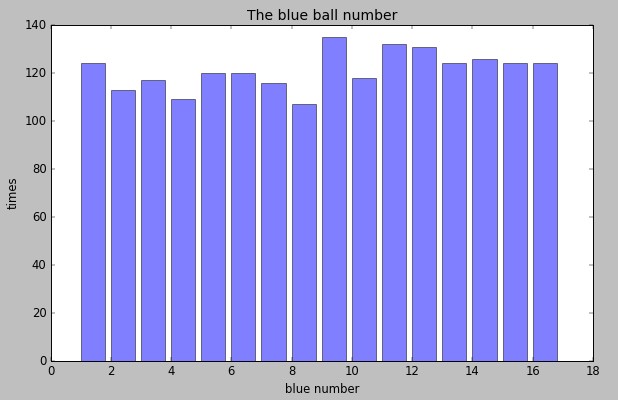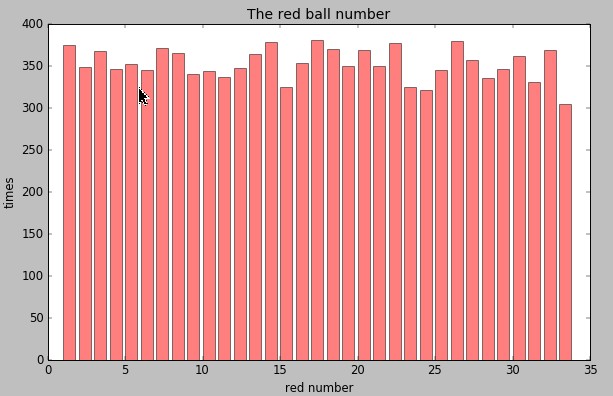本文实例讲述了Python数据分析之双色球中蓝红球分析统计。分享给大家供大家参考,具体如下:
这里接着上一篇Python数据分析之获取双色球历史信息收集的数据处理下,
newdata.txt数据样子
...
2005-08-21, 05,10,23,27,28,30,15
2005-08-18, 04,05,17,18,26,33,04
2005-08-16, 09,12,18,21,28,29,05
...
一、蓝球统计:
analyze_data_lan.py
|
1
2
3
4
5
6
7
8
9
10
11
12
13
14
15
16
17
18
19
20
21
22
23
24
25
26
27
28
29
30
31
32
33
34
35
36
37
38
|
#!/usr/bin/python# -*- coding:UTF-8 -*-#调用pandas numpy matplotlib包import pandas as pdimport numpy as npimport matplotlib.pyplot as plt#读取newdata.txt文件df = pd.read_table('newdata.txt',header=None,sep=',')# print df# print df[1:3] #第2到第3行(索引0开始为第一行,1代表第二行,不包含第四行)# print df.loc[0:10,:] #第1行到第9行的全部列# print df.loc[:,[0,7]] #全部行的第1和第8列tdate = sorted(df.loc[:,0]) #取第一列数据# print tdatetdate1 = [] #将tdate数据读取到列表中for i in tdate: tdate1.append(i)print tdate1# s = pd.Series(tdate1, index=tdate1)s = pd.Series(range(1,len(tdate1)+1), index=tdate1) #将日期转换为对应的数值从1开始# print stblue = list(reversed(df.loc[:,7])) #对数据取反print tbluefenzu = pd.value_counts(tblue,ascending=False) #将数据进行分组统计,按照统计数降序排序print fenzux=list(fenzu.index[:]) #获取蓝色号码y=list(fenzu.values[:]) #获得蓝色统计数量print xprint y# print type(fenzu)plt.figure(figsize=(10,6),dpi=70) #配置画图大小、和细度plt.legend(loc='best')# plt.plot(fenzu,color='red') #线图plt.bar(x,y,alpha=.5, color='b',width=0.8) #直方图参数设置plt.title('The blue ball number') #标题plt.xlabel('blue number') #x轴内容plt.ylabel('times') #y轴内容plt.show() #显示图 |
结果输出:

看来蓝球9选中最多
二、红球统计
analyze_data_hong.py
|
1
2
3
4
5
6
7
8
9
10
11
12
13
14
15
16
17
18
19
20
21
22
23
24
25
26
27
28
29
30
31
32
33
34
35
36
37
38
|
#!/usr/bin/python# -*- coding:UTF-8 -*-import pandas as pdimport numpy as npimport matplotlib.pyplot as plt#读取文件df = pd.read_table('newdata.txt',header=None,sep=',')# print df# print df[1:3]# print df.loc[0:10,:]# print df.loc[:,1:6]tdate = sorted(df.loc[:,0])# print tdateh1 = df.loc[:,1]h2 = df.loc[:,2]h3 = df.loc[:,3]h4 = df.loc[:,4]h5 = df.loc[:,5]h6 = df.loc[:,6]#将数据合并到一起all = h1.append(h2).append(h3).append(h4).append(h5).append(h6)alldata = list(all)print len(alldata)fenzu = pd.value_counts(all,ascending=False)print fenzux=list(fenzu.index[:])y=list(fenzu.values[:])print xprint y# print type(fenzu)plt.figure(figsize=(10,6),dpi=70)plt.legend(loc='best',)# plt.plot(fenzu,color='red')plt.bar(x,y,alpha=.5, color='r',width=0.8)plt.title('The red ball number')plt.xlabel('red number')plt.ylabel('times')plt.show() |
结果输出:

红球1、7、14、17、26选中几率高些
希望本文所述对大家Python程序设计有所帮助。
原文链接:http://blog.csdn.net/levy_cui/article/details/51425644










